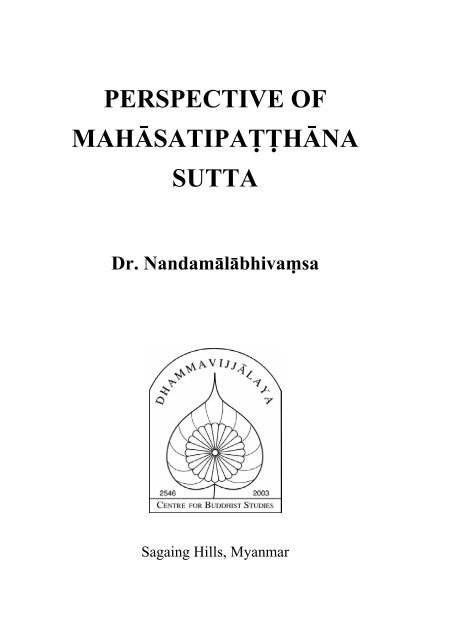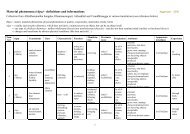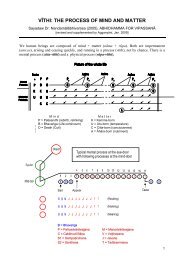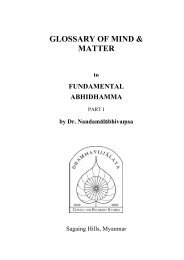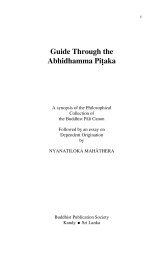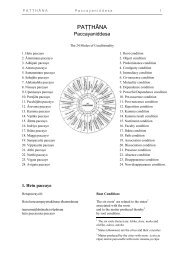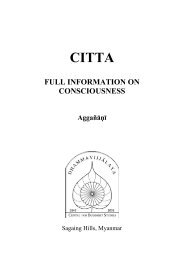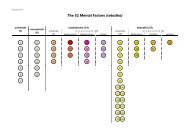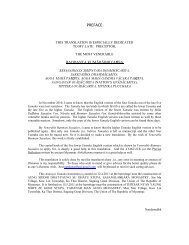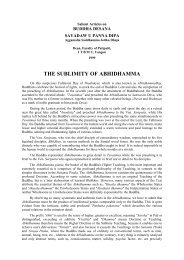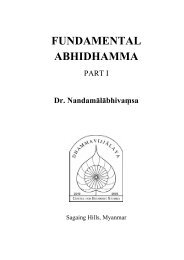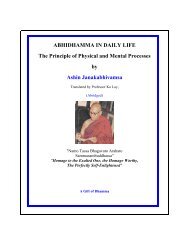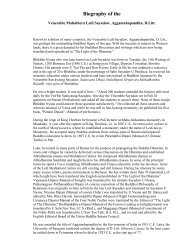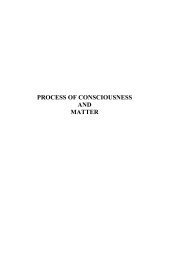perspective of mahÄsatipaá¹á¹hÄna sutta - Abhidhamma.com
perspective of mahÄsatipaá¹á¹hÄna sutta - Abhidhamma.com
perspective of mahÄsatipaá¹á¹hÄna sutta - Abhidhamma.com
- No tags were found...
You also want an ePaper? Increase the reach of your titles
YUMPU automatically turns print PDFs into web optimized ePapers that Google loves.
3. Cittānupassanā16 objects(8) Cittānupassanā, the contemplation <strong>of</strong> the consciousness, shouldbe practised on 16 objects:1. Sarāga citta = consciousness with lust2. Vītarāga citta = consciousness without lust3. Sadosa citta = consciousness with hatred4. Vītadosa citta = consciousness without hatred5. Samoha citta = consciousness with delusion6. Vītamoha citta = consciousness without delusion7. Saṅkhitta citta = constricted consciousness8. Vikkhitta citta = scattered consciousness9. Mahaggata citta = excellent consciousness10. Amahaggata citta = non-excellent consciousness11. Sauttara citta = surpassable consciousness12. Anuttara citta = unsurpassable consciousness13. Samāhita citta = concentrated consciousness14. Asamāhita citta = unconcentrated consciousness15. Vimutta citta = freed consciousness16. Avimutta citta = unfreed consciousness5
4. The 7 Factors <strong>of</strong> Enlightenment(1) Sati = mindfulness(2) Dhammavicaya = investigation <strong>of</strong> Dhamma(3) Vīriya = effort(4) Pīti = joy / rapture(5) Passaddhi = tranquillity(6) Samādhi = concentration(7) Upekkhā = equanimity5. The 4 Noble Truths1. Dukkha = suffering2. Dukkha-samudaya = origin <strong>of</strong> suffering3. Dukkha nirodha = cessation <strong>of</strong> suffering4. Dukkha-nirodha-gāminī-paṭipadā= the path leading to the cessation <strong>of</strong> sufferingWAY OF CONTEMPLATIONMeditation posture:(1) Kāyānupassanāa) ĀnāpānaThe Buddha showed what posture should be selected:- sit cross-legged- keep the body erect- direct the mindfulness to the meditation object7
Meditation on Breath(1) To practise the meditation on breath- direct your mind to the entrance <strong>of</strong> nostrils- observe mindfully the breath- try to see clearly the in-breath and the out-breathbreathe inPracticebreathe out1. keeping mindful2. distinguishing long and short3. making clear the entire boy4. reducing body-conditioned things.Rotation(2) The contemplation <strong>of</strong> the body in the body happens internally, orexternally, or both.Entering to Vipassanā(3) On breath-body the contemplation arises in this way:1. Samudaya-dhammā-nupassī= contemplating the origination factor <strong>of</strong> the breath,or contemplating the arising nature <strong>of</strong> the breath8
2. vaya-dhammā-nupassī= contemplating the dissolution factor <strong>of</strong> the breath,or contemplating the dissolving nature <strong>of</strong> the breath3. samudaya-vaya-dhammānupassi= contemplating the origination and dissolution factor <strong>of</strong>the breath, or contemplating the arising and dissolvingnature <strong>of</strong> the breath.contemplation <strong>of</strong>arising, orceasing, orboth.Attainment(1) The mindfulness well established as “there exists thebreath”. That is for only knowledge and mindfulness.(2) One lives in the breath without craving and wrong view.(3) In the world there is nothing to grasp with craving andwrong view.b) The Posture <strong>of</strong> the BodyThe 2 nd type <strong>of</strong> the contemplation on the body is the physical posture:One has mindfulness on the 4 postures <strong>of</strong> the body to understandthem.posturegoing / walkingstandingsittinglying downunderstandI am goingI am standingI am sittingI am lying downOne understands accordingly however his body is disposed.9
c) Mindfulness with clear ComprehensionThe 3 rd is the mindfulness with clear <strong>com</strong>prehension. Whateverphysical action or manner happens, one applies clear <strong>com</strong>prehension.Physical action / manner1. going forward, going back2. looking straight ahead, looking away from the front3. using robes and bowl4. eating, drinking, chewing, savouring5. obeying the calls <strong>of</strong> nature6. walking, standing, sitting, sleeping, waking, speaking, keeping silentd) Reflection on the Repulsiveness <strong>of</strong> the bodyThe 4 th is the reflection on the repulsiveness <strong>of</strong> the body. One reflectson this body upward and downward. This body is enclosed by theskin and full <strong>of</strong> diverse impurities.Way <strong>of</strong> Contemplation:“There exist in the body:(1) hair, body-hair, nails, teeth, skin,(2) flesh, sinews, bones, marrow, kidneys,(3) heart, liver, intestines, spleen, lungs,(4) bowels, stomach, undigested food, faeces,(5) bile, phlegm, pus, blood, sweat, fat,(6) tears, lymph, saliva, nasal mucus, oil <strong>of</strong> the joints, urine.”10
e) Reflection on the Material ElementsThe 5 th is the reflection on the material elements.Way <strong>of</strong> Contemplation:“There exist in this body the earth element, the water element, thefire element and the air element.”(2) VedanānupassanāPractice(a) Mindfulness with understanding: “I am experiencing pleasantfeeling, while he experiences a pleasant feeling, and so on.”(b) Rotation internal, external feeling, and both.(c) Contemplation <strong>of</strong> the arising conditions, ceasing conditions andboth dealing with feeling.Attainment(1) Mindfulness well established as “there exists feeling”. That isonly for knowledge and mindfulness.(2) One lives in feeling without craving and wrong view.(3) In the world there is nothing to grasp with craving and wrongview.11
(3) CittānupassanāPractice(a) Mindfulness with understanding: “My mind is with lust, if themind is with lust, and so on.”(b) Rotation internal, external mind, and both.(c) Contemplation <strong>of</strong> the arising conditions, ceasing conditions andboth dealing with mind.Attainment(1) Mindfulness well established as “there exists mind”. That isonly for knowledge and mindfulness.(2) One lives in mind without craving and wrong view.(3) In the world there is nothing to grasp with craving and wrongview.(3) DhammānupassanāPractice1. The realization <strong>of</strong> the Hindrances:(a) if exist, one realizes it exists.(b) if not exist, one realizes it does not exist.(c) how it arises from unarisen situation.(d) how it is to be removed after having arisen.(e) how it never <strong>com</strong>e again after having been removed.12
2. The realization <strong>of</strong> the Aggregates <strong>of</strong> clinging:(a) This is matter, etc.(b) This is the cuase <strong>of</strong> matter, etc.(c) This is the cessation <strong>of</strong> matter, etc.3. The realization <strong>of</strong> the Sense-bases:(a) One realizes eye, etc.(b) realizes visible form, etc.(c) realizes the fetter that occurs depending on both <strong>of</strong> them(d) realizes how the fetter arises(e) realizes how to remove the arisen fetter(f) realizes how the fetter never <strong>com</strong>es again after having beenremoved.4. The realization <strong>of</strong> the 7 Factors <strong>of</strong> Enlightenment:(a) One realizes “it exists”, if exist;(b) realizes “it does not exist”, if not exist.(c) How it will arise from the unarisen state.(d) How to develop it to be perfect.5. The realization <strong>of</strong> the 4 Noble Truths:One must try to realize the 4 Noble Truths in detail.Conclusion“If anyone develops these 4 Satipaṭṭhānas in such way for sevenyears, he may expect one <strong>of</strong> the two fruitions, either Arahattaphalain this life or Anāgāmitā, if the effect <strong>of</strong> Kamma and Kilesaremains.”13


